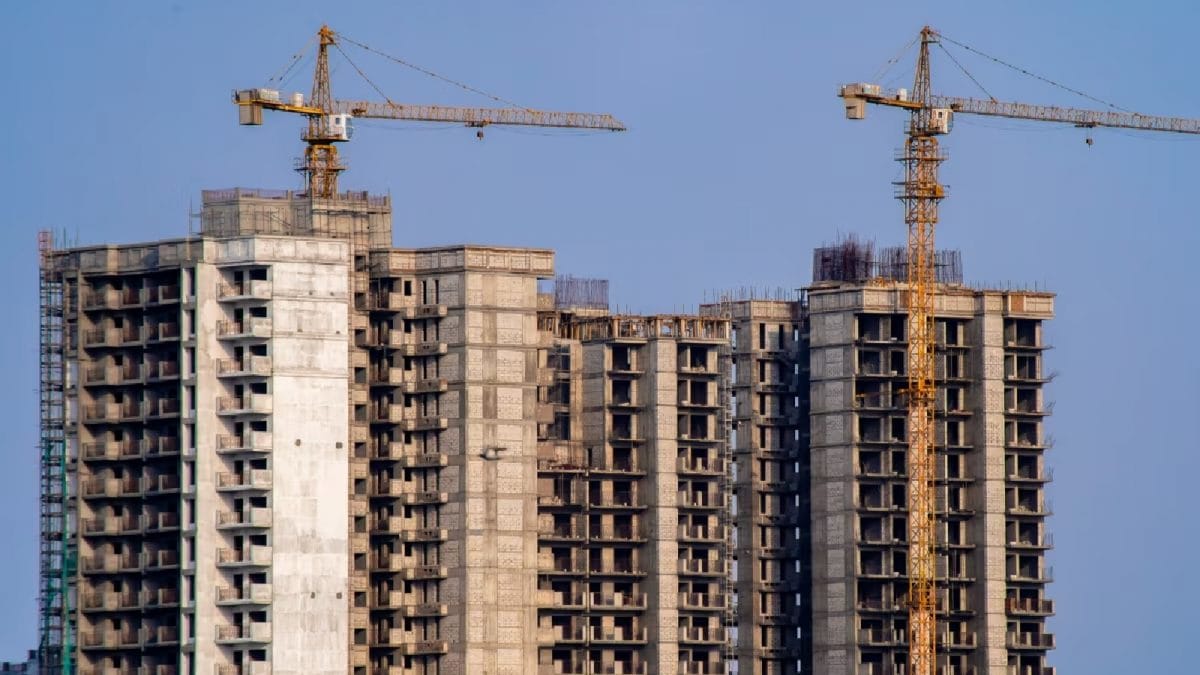Business
GST Reforms 2025: How A Two-Slab Structure Will Transform Indian Real Estate

Last Updated:
Govt plans a two-slab GST reform by Diwali 2025, cutting rates on cement and materials, promising 8-15% savings for homebuyers and transforming real estate with transparency.

The GST reform is expected to particularly benefit affordable housing, with ripple effects across the sector.
Authored By Sahil Agarwal
India’s real estate sector stands on the brink of a revolutionary transformation as the government proposes a simplified two-slab GST structure, replacing the current complex four-tier system. Expected to roll out by Diwali 2025, this reform promises substantial savings for homebuyers while fundamentally reshaping the real estate industry.
The proposal consolidates GST into just 5% and 18% slabs, eliminating the existing 12% and 28% brackets. Research by ClearTax indicates that 99% of items in the 12% bracket will move to 5%, while 90% of items in the 28% bracket will shift to 18%. This rationalization will significantly lower construction costs, with homebuyers emerging as the primary beneficiaries.
Cement, currently taxed at 28%, will drop to 18%, a 10 percentage point reduction. Paint and other construction materials will see similar cuts. These reductions are expected to translate into 8-15% savings for residential buyers. For a Rs 50 lakh apartment, this could mean potential savings of Rs 4-7.5 lakhs.
Industry surveys suggest the reform will alter how developers approach project planning and pricing. With simplified tax structures and lower input costs, the focus will shift from tax optimization to customer value creation. Developers are likely to adopt transparent pricing models and customer-first strategies, broadening the homebuyer base and compelling innovation in design, amenities, and financing partnerships.
The reform is poised to particularly benefit affordable housing, with ripple effects across the sector. Price-sensitive buyers in tier-II cities such as Pune, Ahmedabad, Kochi, and Indore are expected to drive unprecedented demand growth. Data from ASSOCHAM indicates the simplified GST structure will bring millions of first-time buyers into the market. Developers will need to tailor projects for young professionals and growing families, reshaping portfolios and accelerating residential expansion beyond metros.
On the supply side, the two-slab structure will revolutionize real estate operations. Predictable tax rates will enable developers to forge long-term supplier relationships and streamline procurement, reducing project timelines and enhancing quality. Simplified compliance will free up resources for PropTech adoption, digital customer experiences, and process automation, modernizing industry operations.
Banks and housing finance companies will also benefit, with clearer cost structures leading to faster loan approvals and innovative financing products. Stronger partnerships between developers and financial institutions are expected, expanding homebuyer financing options. Smaller developers will gain from reduced compliance costs, while larger players will need to compete on innovation and customer service rather than tax structuring expertise.
Ultimately, the industry will witness a clear shift toward innovation, customer focus, and operational efficiency. This reform represents one of the most significant structural changes in Indian real estate in decades — one that promises to democratize homeownership while driving transparency, efficiency, and customer-centric growth across the sector.
(The author is the chief executive officer of Nimbus Realty)
A team of writers and reporters decodes vast terms of personal finance and making money matters simpler for you. From latest initial public offerings (IPOs) in the market to best investment options, we cover al…Read More
A team of writers and reporters decodes vast terms of personal finance and making money matters simpler for you. From latest initial public offerings (IPOs) in the market to best investment options, we cover al… Read More
Read More
Business
RMB valuation and limits of traditional exchange rate models | The Express Tribune

Global focus is on the Chinese currency, sparking debate over whether it is overvalued or undervalued
Foreign exchange reserves have started increasing on the back of recent loans by the AIIB, World Bank, and ADB. The reserves stand over $8.2 billion, and the IMF board is also expected to approve a $700 million tranche this Thursday. photo: file
KARACHI:
China’s merchandise trade surplus surged by $111.7 billion in November, reaching an impressive $1.08 trillion for the first 11 months of the year, a 22.1% increase compared to the same period of last year, according to official data. Western media has described the massive trade surplus as “remarkable,” but also warned that it could be “unsustainable,” citing concerns over China’s undervalued renminbi (RMB).
The soaring surplus has raised eyebrows among economists, many of whom have called on Beijing to allow the renminbi to appreciate more gradually over the next five years. They argue that a stronger currency could help boost China’s imports while providing relief to global competitors in Europe, the US, and other regions, who are increasingly losing market share to Chinese exports.
Global market attention has long been fixed on the trajectory of the renminbi, with renewed debate over whether the Chinese currency is overvalued or undervalued. Recent studies, relying on traditional neoclassical exchange-rate models, suggest that the RMB is deviating from its “equilibrium value.” However, economists warn that these conclusions are heavily influenced by the analytical frameworks used and may fail to account for the crucial role that modern financial forces play in shaping currency values.
Judging whether an exchange rate is misaligned is not simple. It’s inherently complex. Conventional neoclassical frameworks – such as the purchasing power parity (PPP) and the Balassa-Samuelson hypothesis – focus on real-economy fundamentals, including productivity, prices and the current account. These models generally view capital flows and foreign-exchange trading as short-term reactions to real economic factors, rather than as independent forces that can influence long-term exchange-rate trends.
That assumption is increasingly called into question in modern highly financialised global economy. Annual foreign-exchange trading volumes are now many times larger than global trade in goods and services, suggesting that frameworks focused primarily on trade balances and relative prices may be far removed from market realities.
Conversely, (post)-Keynesian approaches argue that capital flows, financial cycles and shifts in expectations lie at the heart of exchange-rate movements. While these approaches do not dismiss the importance of the real economy or the current account, they contend that under modern financial systems, capital movements can influence both short-term fluctuations and long-term currency trends. Exchange rates implied by PPP, they argue, may never be reached and can diverge persistently in one direction.
The two approaches, according to economists, need not be viewed as mutually exclusive. Yet continued reliance on a purely neoclassical lens risks producing serious misjudgments, particularly during periods of heightened financial volatility. A comprehensive analysis, they argue, must account for both real-economy fundamentals and financial forces, with the latter often playing a decisive role.
The renminbi clearly exemplifies this debate. When China’s position in the financial cycle is taken into account – rather than focusing narrowly on the current account or productivity – recent movements in the currency appear less anomalous. Once financial-cycle dynamics are incorporated, the RMB may not deviate significantly from any plausible notion of an “equilibrium exchange rate”, assuming such a benchmark exists at all.
Neoclassical exchange-rate theory is based on several core assumptions: efficient markets, rational agents, flexible prices and wages, and the neutrality of money. Within this framework, trade imbalances are expected to self-correct through exchange-rate adjustments. A country running a persistent current-account deficit should see its currency depreciate, while surplus countries should experience appreciation. Over time, exchange rates are assumed to converge towards levels determined by real fundamentals.
However, real-world evidence frequently contradicts these predictions. The United States, for example, has run large and persistent trade deficits for decades without experiencing a corresponding long-term decline in the dollar. In the 1990s, the US trade deficit widened even as the dollar strengthened. Similarly, China’s own experience has shown that the relationship between the RMB and the current account has been far from stable, despite the presence of capital controls.
(Post-)Keynesian economists argue that these anomalies reflect the growing dominance of financial forces. According to data from the Bank for International Settlements (BIS), daily global foreign-exchange trading reached about $7.5 trillion in 2022, dwarfing annual global trade flows of roughly $32 trillion. In such an environment, exchange rates are shaped primarily by financial transactions, capital flows and expectations rather than by trade fundamentals alone.
Under this view, exchange rates are not anchored to a stable long-run equilibrium. Instead, they reflect the cumulative outcome of short-term movements driven by investor sentiment, risk perceptions and shifts in global liquidity. Capital flows can sustain currency misalignments for extended periods, and there is no automatic mechanism ensuring that current-account imbalances are corrected through exchange-rate changes.
China’s post-2005 experience offers a case in point. Following reforms to the exchange-rate regime, the RMB underwent a period of nominal appreciation alongside rising domestic prices, resulting in sustained real effective exchange-rate appreciation. This pattern is difficult to reconcile with PPP-based mean-reversion models but is consistent with a financial-cycle perspective, in which capital inflows, rising asset prices and credit expansion reinforce one another.
More recently, the picture has shifted. Despite steady improvements in manufacturing capability and productivity upgrades, the RMB’s real effective exchange rate has depreciated. BIS data show that between January 2022 and October 2025, the RMB’s real effective exchange rate declined by around 16%. This outcome runs counter to predictions based on the Balassa-Samuelson hypothesis, which would expect productivity gains to translate into real appreciation.
Economists attribute this divergence to China’s position in a downswing of the financial cycle. As credit growth slowed, domestic demand weakened and price pressures eased, the extent to which productivity gains could support currency strength is limited. At the same time, reduced incentives for holding RMB-denominated assets contributed to periods of depreciation against the dollar.
Signs are now emerging that the financial-cycle adjustment may be nearing its end. As conditions stabilise, incentives for capital allocation into RMB assets are beginning to recover, a shift that has already been reflected in recent currency movements. Against this backdrop, analysts argue that claims of significant RMB undervaluation based solely on traditional models may be overstated.
The broader lesson, economists say, is that exchange-rate analysis must evolve with the structure of the global economy. In an era dominated by finance, capital flows and expectations, frameworks that marginalise these forces risk misreading both the causes and consequences of currency movements.
The writer is an independent journalist with a special interest in geoeconomics
Business
HDFC Bank Changes Lounge Access Norms For Debit Cards From January 10– Details Here

New Delhi: If you often use your HDFC Bank debit card for free airport lounge access, this update is important for you. The bank has changed how complimentary lounge entry works on its debit cards. Instead of simply swiping your card at the lounge, customers will now need a digital voucher to get access. Also, the minimum spending requirement has been increased, reported Moneycontrol. These new rules will come into effect from January 10, and will apply to eligible debit cardholders going forward.
How the New Lounge Voucher System Works
Once your eligibility is confirmed, HDFC Bank will send you an SMS or email with a link to claim your lounge access voucher. You’ll need to verify your request by entering an OTP sent to your registered mobile number. You will receive a voucher code or QR code after successful verification which must be shown at the airport lounge to get entry.
Minimum Spend Requirement Increased
Under the revised rules, HDFC Bank debit card users will now need to spend at least Rs 10,000 in a calendar quarter to be eligible for complimentary airport lounge access. Earlier, the minimum spend required was Rs 5,000.
However, this condition will not apply to HDFC Infiniti Debit Card holders. Customers using the Infiniti card will continue to enjoy free lounge access without any minimum spending requirement.
Eligible Transactions and Free Lounge Visits by Card Type
Only purchase transactions made using the debit card will be considered while calculating the quarterly spending requirement. Other types of transactions will not be counted, as noted by Moneycontrol.
Meanwhile, the number of complimentary lounge visits remains unchanged and continues to depend on the debit card variant:
Millennia Debit Card: 1 free visit per quarter
Platinum Debit Card: 2 free visits per quarter
Times Points Debit Card: 1 free visit per quarter
Business Debit Card: 2 free visits per quarter
GIGA Debit Card: 1 free visit per quarter
Infiniti Debit Card: 4 free visits per quarter
This means cardholders should check both their spending eligibility and card type to know how many lounge visits they can enjoy.
Which Transactions Count and Voucher Validity Explained
Only purchase transactions made using the debit card will be counted towards the quarterly spending requirement. As per Moneycontrol, the following transactions will not be included:
ATM cash withdrawals
UPI or wallet payments (GPay, PhonePe, Paytm, etc.)
Credit card bill payments made via debit card
Debit card EMI transactions
New debit cardholders will also need to meet the Rs 10,000 spending requirement to become eligible for complimentary lounge access.
Voucher Validity:
Once issued, the lounge access voucher will remain valid till the end of the next calendar quarter, after which it will expire if not used.
What This Means for Debit Card Users
With the updated lounge access rules, HDFC Bank is clearly encouraging higher card usage and digital verification. Customers who regularly use complimentary lounge benefits will now need to keep a close watch on their quarterly spending and complete the voucher process in advance. As per Moneycontrol, physical debit card swipes will no longer work from January 10, making it important for travellers to switch to the new digital voucher system.
Business
NPS Changes In 2025: Know New Rules On Exit, Withdrawal, Lock-In And Entry

Pension Fund Regulatory and Development Authority has amended NPS exit and withdrawal rules to give subscribers greater flexibility, choice and control over their retirement savings.

The revised rules primarily target the non-government sector, where NPS participation is voluntary, covering both All Citizen and Corporate subscribers.

Non-government subscribers with an NPS corpus of more than Rs 12 lakh can now withdraw up to 80% of their savings as a lump sum, with only 20% mandatorily allocated to an annuity.

For All Citizen subscribers, the minimum lock-in period for premature exit has been removed, easing access to accumulated pension wealth.

At normal exit, non-government NPS subscribers can now withdraw up to 80% of their corpus as lump sum, with the mandatory annuity portion reduced to 20%.

The threshold for 100% lump-sum withdrawal has been raised significantly, with greater flexibility through systematic lump-sum or unit withdrawals for mid-sized corpuses.

Individuals joining NPS after age 60 will no longer face a vesting period and will also be eligible for up to 80% lump-sum withdrawal at exit.

Up to 25% of own contribution can be withdrawn for housing, medical needs, or loan repayment, with clearer timelines.

While core annuity requirements for government subscribers remain unchanged, higher corpus thresholds and systematic withdrawal options have been introduced.

The maximum entry and exit age under NPS has been increased to 85 years, allowing subscribers to stay invested longer.

Subscribers can now seek financial assistance from regulated institutions, with lenders allowed to mark lien on up to 25% of the subscriber’s own NPS contribution.

By simplifying exits, expanding withdrawal choices and improving liquidity, the amendments aim to make NPS more inclusive while safeguarding long-term retirement income.
-

 Business1 week ago
Business1 week agoHitting The ‘High Notes’ In Ties: Nepal Set To Lift Ban On Indian Bills Above ₹100
-

 Business7 days ago
Business7 days agoStudying Abroad Is Costly, But Not Impossible: Experts On Smarter Financial Planning
-

 Business7 days ago
Business7 days agoKSE-100 index gains 876 points amid cut in policy rate | The Express Tribune
-

 Sports6 days ago
Sports6 days agoJets defensive lineman rips NFL officials after ejection vs Jaguars
-

 Tech1 week ago
Tech1 week agoFor the First Time, AI Analyzes Language as Well as a Human Expert
-

 Entertainment6 days ago
Entertainment6 days agoPrince Harry, Meghan Markle’s 2025 Christmas card: A shift in strategy
-

 Business4 days ago
Business4 days agoBP names new boss as current CEO leaves after less than two years
-

 Tech4 days ago
Tech4 days agoT-Mobile Business Internet and Phone Deals






